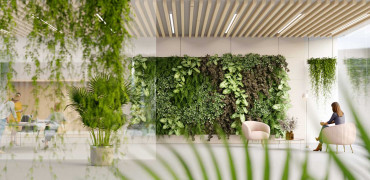As we hurtle towards a daunting and uncertain future, the realisation that we need to change our ways in all aspects of our lives should be filtering in. A huge proportion of our time is spent at home and in buildings, so lets start there…
The world’s oldest building material is undergoing a revolution. Timber was once used to construct the majority of our buildings.
Surpassed now obviously by steel and concrete, which dominates our environment and covers a huge swath of our globe.
However we now know that the future of the construction industry cannot lie within all that is man made and therefore timber once again has the potential to be included in the future of construction, at the very least a discussion.
Wood is appealing and versatile and promotes a feeling of wellbeing both mentally and physically.
Good for wellbeing
Engineered timber products are growing in popularity, literally!
Wood is the only truly sustainable construction material and therefore managed forest areas globally must be increased carefully and sustainably to meet our growing future demand.
The benefits of using timber in construction are both well documented and complicated.
Wood is appealing and versatile. As humans we enjoy being, living and working in buildings constructed from natural materials.
Wood promotes a feeling of wellbeing both mentally and physically.
Studies have proven that working in a timber building even improves productivity.
Not only is wood a desirable building material for the consumer but I would suggest it is now an urgent requirement for the developer too.
The climate crisis surrounds us and net zero becomes more and more pressing.
Steel and concrete no longer feel entirely viable, timber must be considered as maybe not an alternative but certainly as an inclusion.
Don't forget, a wooden construction cleverly stores its carbon dioxide and will do so for its lifetime.
Safety concerns
But is timber safe? Our confidence in this material needs to improve if we are to see an increase in the use of timber structures.
In fact, timber is surprisingly highly fire resistant. When the external layers begin to burn they protect the core for long periods.
In fact, timber structures can significantly outlast unprotected steel buildings in fire resistance.
In France today, all public buildings are required to be of 50% timber construction.
The most commonly used structural timber product is CLT (cross laminated timber) To create CLT, wooden boards are trimmed and kiln dried, they are then glued in layers, crosswise, with the grain of each layer facing against the grain of another.
Stacking the boards in this manner creates large slabs that can match or even exceed the performance and strength of steel.
CLT can in fact be used to make floors, walls and entire buildings.
The world's tallest mass timber structure is in Norway, it stands at 18 stories and over 280ft.
The benefits are clear
Despite all these impressive credentials mass-timber buildings still make up a tiny proportion of buildings constructed each year.
Mass timber allows for quicker and cleaner construction. Timber is less carbon intensive to manufacture and transport. This is a way to reduce the carbon impact of construction.
Prefabricated buildings made from timber for example are manufactured in remote factories and transported to site.
The benefits for our carbon neutral future are clear. Faster construction times, better more sustainable products, less waste, lower costs, less noise, less disruption, improved health and safety, and importantly continuity.
Concrete still has the advantage over timber for reasons that are complex and varied, however it remains clear that there are many benefits for choosing timber as discussed here.
The shift to timber in construction isn’t going to solve climate change but it can certainly be considered as a constructive contribution.
In order to realise its true potential it is important that architects, designers and developers view timber as a valuable component of the construction mix, a green one.
Kirsty Hammond is editor and publisher of Specifier Review, which posts building product and project news



